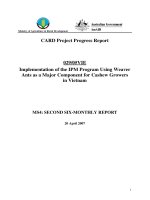Card Project :" Sustainable and profitable development of acacia plantations for sawlog production in Vietnam - MS4 " potx
Bạn đang xem bản rút gọn của tài liệu. Xem và tải ngay bản đầy đủ của tài liệu tại đây (29.98 KB, 3 trang )
CARD Project: 032/05VIE
Sustainable and profitable development of
acacia plantations
for sawlog production in Vietnam
MS4: Acacia silvicultural guidelines manual
Silvicultural guidelines for Acacia plantations
managed for sawlog production in Vietnam
These guidelines are based on two reviews carried out for the CARD Project 032/05
“Sustainable and profitable development of acacia plantations for sawlog production
in Vietnam”.
• Review of Acacia genetic resources and propagation methods to support sawlog
production in Vietnam (November 2006)
• Effects of site management practices and silviculture on productivity of short
rotation Acacia plantations in Vietnam - a review (January 2007)
It is emphasised that these guidelines are interim and will be revised once more
information is obtained through the project.
1. Species and varieties
Selected clones of the acacia hybrid (A. mangium x A. auriculiformis) and the best
improved planting material of A. auriculiformis (selected clones and improved seed)
and A. mangium (improved seed) are best suited for sawlog production. These three
options are already proven in this role in lowland regions of Vietnam receiving at
least 1000 mm annual rainfall. Acacia. crassicarpa performs well on seasonally
flooded sandy soils in central Vietnam.
2. Site preparation
In the absence of more specific information, planting holes dug about one month
before planting where two-thirds of the hole is filled with a mixture of top soil and
fertiliser is recommended. The size of hole is normally 30 cm deep, 20 cm wide at
the base and 30-to-40 cm square at the top.
3. Initial spacing
The most suitable stocking for pulpwood plantations is between 1111 trees ha
-1
(initial
spacing of 3 m x 3 m) and 1666 trees ha
-1
(3 m x 2 m). The necessity to select final
crop trees that meet the requirements of growth rate and form in plantations managed
for solid wood suggests that at least 1000 trees ha
-1
should be planted where the
intended product is solid wood.
4. Fertilizer application
Application of fertiliser at planting and six months after planting has significantly
improved the growth of Acacia in a number of field trials. The highest dose used to
date has been 25 g N, 25 g P and 20.7 g K and 100g micro-organism enriched
fertilizer per seedling, applied to Acacia hybrid at planting. It is not yet possible to
identify the best fertilizer type for common soil environments or to provide a financial
cost-benefit analysis for fertilizer application.
5. Weed control
Weed control, either by manual weeding or herbicide application, has been shown to
improve stand productivity. At least two weedings per year during the first two years
of plantation growth are recommended. After this time, weed growth is suppressed
2
by the development of the tree canopy, at least on the more productive sites. On
poorer sites weed control may be necessary for a longer period of time.
6. Pruning
#
A first-lift pruning should be undertaken at the time of canopy closure and before
crown lift has commenced. Trees selected for pruning will be determined by their
form, the characteristics of the branches and diameter at breast height. The number of
trees pruned will be determined by the distribution of log sizes required at harvest.
No more than 30% of the green crown length from below should be removed when
the selected trees are lift pruned. Form pruning may be required before canopy
closure occurs to increase the numbers of trees that meet the requirements for
selection for lift pruning.
7. Thinning
#
Thinning to stockings lower than that used at planting (at least 1000 trees ha
-1
) is
required if the final crop trees are to produce typical minimum required sawlog
dimensions. The maximum final stocking will not exceed 600 trees ha
-1
. For trees
that produce sawlogs of sawlogs 2 m or more in length and with a 200 mm small-end
log diameter under bark, lower final stockings will be required. Without thinning,
only a very small percentage of final crop trees will produce logs of these dimensions,
even on the most productive sites.
#
Updating the guidelines for pruning and thinning form a key part of the current project
3









